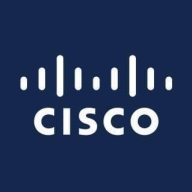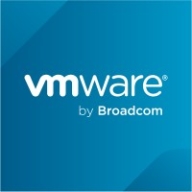

Cisco Umbrella and VMware VeloCloud SD-WAN are prominent players in the DNS security and network optimization categories respectively. While Cisco Umbrella leads with its advanced DNS security features, VMware VeloCloud excels in network performance optimization.
Features: Cisco Umbrella provides excellent DNS security with malware and phishing protection, enabling custom category blocking and operating smoothly without client-side installations. On the other hand, VMware VeloCloud SD-WAN offers Dynamic Multipath Optimization for enhanced connectivity, zero-touch provisioning, and efficient load balancing to optimize network operations.
Room for Improvement: Cisco Umbrella could enhance its reporting capabilities, expand integration with other systems, and improve documentation for complex deployments. Users also wish for more advanced security features like IPS/IDS and better user-level controls. VMware VeloCloud SD-WAN needs improvements in security functionalities and integration capabilities and would benefit from enhanced advanced routing policies support. Users also cite the need for cost reductions and improvements in failover mechanisms.
Ease of Deployment and Customer Service: Cisco Umbrella's cloud-based model simplifies deployment, offering generally good technical support, though operational support can improve with more direct contact methods. VMware VeloCloud SD-WAN provides flexible deployment options across various cloud environments, though its licensing model may cause complexity. Customer service is praised for quick technical support, though initial setup guidance could be better.
Pricing and ROI: Cisco Umbrella is often perceived as pricey but is seen as delivering good ROI through strong security features and increased operational efficiency, particularly benefiting organizations with complex security needs. VMware VeloCloud SD-WAN also faces pricing scrutiny due to high costs associated with increased bandwidth and configuration. Despite this, its market competitiveness and infrastructure benefits contribute positively to its ROI in connectivity-focused settings. Pricing structures for both need careful budget consideration.
Cisco is a big brand in the networking domain, but in security, they are pushing a lot and improving day by day.
From my point of view, the biggest return on investment when using the solution is that it makes it a lot easier to delegate some of the tasks that were traditionally used, such as building policies on the firewalls and doing it through Cisco Umbrella.
The biggest return on investment when using Cisco Umbrella for me is the ease of use of the fact that we've deployed this with our Cisco VPN Secure Client, so every computer has the Umbrella module in it.
The deployment time with VMware VeloCloud SD-WAN saves 50 percent compared to traditional MPLS networks.
I would rate customer support ten out of ten due to the excellent assistance throughout the POC process.
Cisco's support is fantastic, providing assistance when needed, especially during the initial installation process.
If I don't need to go to support all the time, that means the product is working fine, so I'm very happy with them.
I appreciate having dedicated service engineers who manage our account and ensure any technical issues are addressed efficiently.
Cisco Umbrella scales incredibly with the growing needs of my organization.
Cisco Umbrella scales really well with the growing needs of my company, bringing the ability to ensure that people are safe and connected.
Cisco Umbrella scales effectively with the growing needs of my company; it's excellent, and I have experienced no issues.
The customer base for VMware VeloCloud SD-WAN has been growing 30 to 40 percent per year when transitioning from traditional MPLS networks.
I have not experienced any major stability issues with Cisco Umbrella.
Cisco Umbrella Secure Access is pretty stable in my mind, and we have not seen many glitches that would have interrupted services at customer locations.
The stability and reliability of the Cisco Umbrella platform have been great.
The technical team from VMware VeloCloud SD-WAN addresses these issues promptly, making us very happy with their support.
Overall, VMware VeloCloud SD-WAN is a stable solution.
Making it more flexible and easy to deploy, particularly when integrating with other technologies like Active Directory and proxies, would be beneficial.
The product can only shield a small area, making it less effective for larger spaces or multiple users.
I have to write an email to Umbrella support to get assistance, unlike the other products where I can call the Cisco technical assistance center and get an engineer.
I would like to see improved security features, such as adding more SASE functions.
Unlike the comprehensive reports we receive from Palo Alto for our firewalls, VMware VeloCloud SD-WAN doesn't offer detailed reports that effectively convey the solution's benefits to management.
We've bundled that with our firewall stuff and our VPN, which brings the price down and adds the ability to grow.
The only cost associated is the license cost unless additional solutions need to be integrated with Umbrella, which would incur extra costs.
The prices need to be lower as the current pricing is exceedingly high.
The pricing is high, making the margin thin, which limits mark-up opportunities from the wholesale price.
The pricing involves licensing for the VeloCloud gateway based on the bandwidth used.
The DNS layer security provided by Cisco Umbrella is very effective for our security posture, offering us vast improvements in visibility over DNS queries and potential threats.
The most valuable feature of Cisco Umbrella is its DNS security.
The best possible thing is that it is very easy to deploy, easy to configure, and very fast to get onboarded with a customer because this is a cloud-based service.
Its proprietary Dynamic Multipath Optimization (DMP) technology is regarded as the most powerful and valuable function by VMware VeloCloud SD-WAN.
Previously, organizations used MPLS links for 1 MB at around $200, but now they can use 4G or 5G SIM cards for half that price while achieving more bandwidth.
VMware VeloCloud SD-WAN has truly transformed our environment, providing significantly more bandwidth at lower costs, which is essential for tasks like Teams calls.
| Product | Market Share (%) |
|---|---|
| Cisco Umbrella | 21.6% |
| Infoblox Advanced DNS Protection | 12.4% |
| Palo Alto Networks DNS Security | 7.5% |
| Other | 58.5% |
| Product | Market Share (%) |
|---|---|
| VMware VeloCloud SD-WAN | 8.0% |
| Fortinet FortiGate | 13.9% |
| Cisco Catalyst SD-WAN | 11.2% |
| Other | 66.9% |

| Company Size | Count |
|---|---|
| Small Business | 49 |
| Midsize Enterprise | 30 |
| Large Enterprise | 51 |
| Company Size | Count |
|---|---|
| Small Business | 23 |
| Midsize Enterprise | 14 |
| Large Enterprise | 20 |
Cisco Umbrella provides fast-deploying DNS-layer security with powerful threat protection capabilities. Trusted by over 30,000 entities, it ranks highly in DNS security and effectively supports secure remote work environments.
Cisco Umbrella offers comprehensive DNS security, web filtering, and ease of use, enhancing network security through robust threat protection and malware prevention. It processes over 600 billion requests daily, making it a leader in its field. The seamless integration with existing infrastructures and cloud-based nature makes it suitable for remote and distributed work environments, ensuring consistent security throughout. Management is streamlined with a single-pane interface that simplifies administration, while in-depth reporting capabilities provide valuable insights for continuous monitoring.
What are the key features of Cisco Umbrella?Cisco Umbrella is widely adopted in industries requiring advanced DNS-level security to counteract malware, phishing, and cyber threats. Its ability to monitor and protect remote and roaming employees makes it an attractive option for sectors highly dependent on cloud services. By managing DNS queries and blocking harmful sites, Cisco Umbrella enhances cybersecurity across networks, providing an added layer of protection for businesses worldwide.
VMware Software-Defined Wide Area Network (SD-WAN) is a secure access service edge (SASE) platform that combines many types of software-based network technologies in an attempt to enable users to virtualize their wide area networks and reduce their reliance on hardware. In essence, this solution makes it possible for users to reliably access their applications from anywhere in the world by leveraging cloud technologies. Users can simply, efficiently, and completely control their network devices and traffic. It ensures that organizations are always able to use the best possible connection to their data centers. VMware SD-WAN steers traffic so that it is always using the most reliable connections and at the same time takes steps to remediate any problems that it detects in other network links. This guarantees that organizations can access high-priority applications at all times.
VMware SD-WAN Benefits
Some of the ways that organizations can benefit by deploying VMware SD-WAN include:
VMware SD-WAN Features
Reviews from Real Users
VMware SD-WAN is a solution that stands out when compared to many of its competitors. Two major advantages it offers are its ability to automate the process of creating and maintaining a virtual local area network and its intuitive user dashboard.
Sami I., principal cloud architect at Loihe, writes, “One of the solution's most valuable features is the VMware core automation stack at an SDDC. It includes NSX, the VMware virtualization layer for the networks (the LAN virtualization), which works extremely well with the VMware SD-WAN solution and is the primary advantage over all the others. None of the other vendors could integrate with the virtual LAN, making it quite complicated and virtualized to be fully automated.”
Chih S., senior technical consultant at a tech services company, says, “The product has a very good user dashboard that is simple to navigate.”
We monitor all Domain Name System (DNS) Security reviews to prevent fraudulent reviews and keep review quality high. We do not post reviews by company employees or direct competitors. We validate each review for authenticity via cross-reference with LinkedIn, and personal follow-up with the reviewer when necessary.